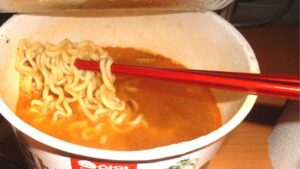Ramen noodles are beloved worldwide for their convenience, tastiness, and budget-friendly price tag. Their instant prep and customizability also make them a dorm room and office lunch staple. But if you find yourself reaching for instant noodles multiple times a week, you may wonder – how often is too often for your health?
The answer lies in moderation. While the occasional ramen meal won’t hurt you, making it a regular part of your diet can negatively impact your health over time. The high sodium, saturated fat, and processed carbs in instant noodles mean they aren’t very balanced nutritionally.
Experts recommend limiting instant ramen intake to just 1-3 times per week at most. Eating it daily is highly discouraged. But you can still enjoy ramen in moderation with the right preparation and balance. Here’s a full breakdown on how often you can healthily eat instant noodles.
Is Ramen Bad For You?
Ramen noodles get a bad reputation as an unhealthy food. But the truth is, ramen isn’t all good or all bad. Here’s the full scoop:
Pros:
- Convenient, quick meal
- Very affordable and accessible
- Often fortified with vitamins
- Can be part of a balanced diet
Cons:
- Low in protein, fiber, vitamins
- High in sodium and saturated fat
- Heavily processed carbs
- MSG, TBHQ preservatives in some
So in moderation, as part of an overall healthy diet, ramen can be perfectly fine. But regularly relying on it as a staple meal can lead to nutritional deficits and health issues.
Health Risks of Eating Too Much Ramen
Eating instant noodles frequently has been linked to health risks like:
- High blood pressure: Excess sodium can raise blood pressure.
- Heart disease: Saturated fats clog arteries and strain the heart.
- Obesity: Refined carbs and fats increase weight gain risk.
- Metabolic syndrome: Characterized by high blood sugar, blood pressure, and obesity.
- Liver damage: Some preservatives like TBHQ may stress the liver.
Moderating ramen intake and choosing lower-sodium, healthier varieties can help mitigate these risks. Balance out the carbs with plenty of veggies, proteins, and healthy fats.
How Often Should You Eat Ramen?
So what’s the magic number for how frequently you can enjoy ramen while limiting health risks? Here are dietitian recommendations:
- Once a week is generally OK.
- At absolute most, limit to 2-3 times per week.
- Never eat ramen daily for prolonged periods.
- Avoid at all if you have any medical conditions impacted by sodium.
- Balance with healthier meals and snacks throughout the week.
Experts suggest treating ramen as an occasional convenience meal rather than a dietary staple. Listen to your body as well. If you experience frequent cravings, crashes, or blood sugar swings from eating ramen often, scale back further.
Healthy Ways to Prepare Instant Noodles
You can still keep ramen in your weekly meal rotation with these nutrition upgrades:
- Choose whole grain or sprouted noodles.
- Use only half the seasoning packet.
- Load with veggies like spinach, carrots, mushrooms.
- Add lean protein like chicken, shrimp, or egg.
- Make broth from scratch with low-sodium ingredients.
- Flavor with garlic, ginger, herbs, chili oil instead of salt.
- Swap starchy noodles for veggie noodles or shirataki noodles on occasion.
With the right preparations and ingredients, ramen can be transformed into a balanced meal when cravings strike! Just be mindful of portions and frequency.
Tips for Choosing Healthier Ramen Brands
When shopping for instant noodles, compare brands and choose ones with:
- Less than 800mg sodium per serving
- 3+ grams fiber
- Less than 5g saturated fat
- No TBHQ in ingredients
- Short ingredient list with recognizable foods
- Whole grain or sprouted noodles
- Added protein and vitamins
Pay attention to labels to avoid unhealthy varieties. Look for low-sodium options without excessive preservatives. And know that fancier organic or gluten-free options aren’t necessarily healthier.
Signs You’re Eating Too Much Ramen
If you frequently experience any of the following, it’s a sign to cut back on the noodles:
- High blood pressure
- Weight gain
- Digestive issues
- Bloating, water retention
- Frequent cravings and hunger
- Energy crashes
- Blood sugar fluctuations
- Increased inflammation
- Nutrient deficiencies
Listen to your body! It will let you know if your ramen habit needs reining in.
Healthier Noodle Alternatives to Try
For more nutrition, try swapping your ramen for these lower-carb, higher-protein noodles:
- Zucchini noodles
- Spaghetti squash
- Shirataki noodles
- Seaweed noodles
- Bean thread noodles
- Rice noodles
- Soba noodles
- Glass noodles
- Edamame noodles
- Chickpea pasta
There’s a whole noodle world to explore beyond instant ramen! Change up your noodle bowl game with a rotating cast of healthier options.
The Takeaway
At the end of the day, instant noodles are best enjoyed in moderation as part of an overall balanced diet, rather than as a daily dietary staple. To limit health risks, aim for just 1-3 servings per week, avoid excessive sodium, and bulk up your bowls with nutritious add-ins. Listen to your body’s signals and adjust your ramen intake accordingly for optimal wellbeing.





